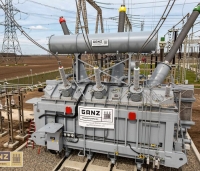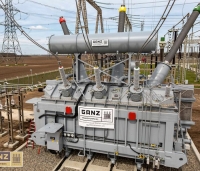“Turkic World Vision–2040” outlines a plan for economic cooperation and development among Turkic States. In a global landscape marked by conflicting forces of globalization and fragmentation, the debate emerges regarding the necessity and feasibility of economic integration within the Organization of Turkic States (OTS).
The emerging global economic landscape marks a transformative era, propelled by globalization, the shifting balance of power towards emerging economies, technological progress, and climate change. As the world grapples with these shifts, it becomes imperative for OTS countries to adeptly respond and seize the opportunities unfolding in this new era. Through embracing innovation, fostering inclusivity, and adopting sustainable practices, we can forge a future that is both prosperous and equitable for all. Similar to how certain organisms survived the Cretaceous–Paleogene extinction event some 66 million years ago by adapting to their environment, economies must also evolve to meet the demands of the changing global economic terrain. By promoting economic cooperation, advancing technology and innovation, championing sustainable development, fostering cultural exchange, and facilitating political collaboration among member states, OTS’s endeavors could significantly contribute to the adaptation and resilience of member economies in this new world order (Figure 1 and Figure 2)
The escalating competition among major global powers has had a detrimental impact on the efficacy of formal collaborations involving multiple nations. This trend is also observable in less structured forums like the G7, G20, and BRICS. However, amid these challenges, new dynamics have surfaced worldwide. For example, official documentation underscores that the OTS operates through various principal organs, including the Council of Heads of State, the Council of Foreign Ministers, the Council of Elders, the Senior Officials Committee, and the Secretariat. The organization’s activities are further reinforced by affiliated institutions such as the Parliamentary Assembly of Turkic Speaking Countries (TURKPA), the International Organization of Turkic Culture (TURKSOY), the International Turkic Academy, the Turkic Culture and Heritage Foundation, the Turkic Business Council, the Turkic University Union, and the Turkic Chamber of Commerce and Industry.
The core inquiry concerning Turkic states revolves around their simultaneous use of existing integration platforms while also exploring new integration pathways within the Organization of Turkic States. This phenomenon corresponds to what O’Reilly and Tushman define as ambidexterity. By highlighting this aspect, the challenges encountered by Turkic states have spurred us to undertake this research, which is supported by reputable think tanks from all OTS members. The ultimate outcome of Turkic states’ efforts to achieve economic competition, a blend of cooperation and competition, remains uncertain. The fact that rivals are increasingly collaborating to balance risks and rewards adds an intriguing dimension. Nonetheless, there are numerous potential advantages to bolstered economic cooperation, rendering it a priority issue for policymakers in the foreseeable future.
Pankaj Ghemawat asserts that globalization has brought people, countries, and markets closer together to an unprecedented extent, leading us to believe that national borders are now obsolete remnants of the past (Ghemawat, 2007). However, upon a meticulous examination of the data, it becomes apparent that the world is far less integrated than previously believed. A recent document from MGI reveals that the growth in global flows is currently propelled by intangible assets, services, and talent. The prevailing geopolitical dynamics are presenting considerable obstacles to global cooperation, which typically serves as a safeguard against global risks. As per the Global Trends 2040 report by the US National Intelligence Council, it is unlikely for any single nation to dominate all regions or domains, and a wider array of actors will engage in competition to advance their ideologies, objectives, and interests. The world, depicted as Separate Silos, appears fragmented into several economic and security blocs of varying sizes and strengths, with a focus on self-sufficiency, resilience, and defense. These blocs revolve around key powers such as the United States, China, the European Union (EU), Russia, and a few regional players.
In this context, regional organizations like the Organization of Turkic States assume crucial responsibilities. By promoting resilience at the regional level, they can have a cascading effect on enhancing global resilience within the multilateral system, which operates based on a rules-based order. “Turkic World Vision–2040” announces: “We are living in an age that requires a strategic vision to recognize and address the rapid changes worldwide and their impact on us.” Raghuram Rajan, a professor of finance, said security considerations had become “a front for all kinds of protectionism”.
The growth rate of the KOF Globalisation Index, which assesses the economic, social, and political aspects of globalization, has experienced a deceleration over the past decade. Among the members of the Organization of Turkic States (OTS), Hungary emerged as the most globalized economy, scoring 83.83 on the KOF Globalisation Index and securing the 17th position in 2019. It was followed by Türkiye (56th), Azerbaijan (72nd), Kazakhstan (81st), Kyrgyzstan (91st), Uzbekistan (131st).
Diverse preferences regarding globalization stem from factors such as geo-economics, geo-politics, and the varied affiliations of OTS members with different regional structures. As globalization continues and overlaps with membership in various blocs, the OTS itself is growing stronger, fostering intensified direct relations among member states. Initially established in 1991 as a summit for the heads of Turkic states, the organization was founded as the Cooperation Council of the Turkic Speaking States in 2009 and transitioned from a council to an organization in 2021. With its headquarters in Istanbul, OTS aims to promote comprehensive cooperation among Turkic states.
Akinci mentioned that in the middle of Eurasia, which has been under foreign rule/influence for the past 200 years, the historical Turkic Belt stretching from the Mediterranean to the Pacific has revived again. Turkic Belt is situated in the Mackinder’s Heartland laying at the center of the world island, covering more than 4.8 million km2, in other words, bigger than EU’s territory.
If the OTS were considered a country, with its population of 174 million, GDP of $1.4 trillion, and trade turnover of $856 billion, it would rank among the top ten.
Huntington (2000), Sachs (2000), Porter (1990) argues how culture influences development. Common historic and cultural ties are a key factor not only in developing relations among the Turkic people, but also in the cooperation of other nations that share kinship ties throughout the modern world.
A graph theory is used to identify pairwise relations between Turkic States, which are made up of nodes that are connected by edges: Azerbaijan represents a node with higher degree centrality in terms of inflowing and outflowing foreign direct investment, while Turkey represents a node with high degree centrality in terms of foreign trade. High degree centrality resembles the red apple («Kızıl Elma»), which represents the main goal that OTS members pursue.
This theory is a versatile tool for studying economic networks, including trade and financial networks. Social network analysis and graph theory are applied to analyze FDI and trade networks in the Turkic World, where nodes represent countries and edges represent investment or trade connections. This approach employs centrality measures such as degree centrality (input and output), closeness centrality, betweenness centrality, and eigenvector centrality. These measures facilitate the evaluation of node influence, distance, bridging roles, and relative effects within the networks. The parameters of the network according to different types of centrality by country are given in Table 1.
The results reveal the centrality measures of Turkic States in both FDI and trade networks. Azerbaijan emerges as the primary FDI hub, followed by Kazakhstan and Kyrgyzstan. In trade relations, Turkey stands out as the central node, exhibiting high degree centrality indicative of a diverse range of exported goods. The analysis also underscores the relationship between centrality and the relative comparative advantage index in trade.
According to results of the model Azerbaijan, Kazakhstan and Kyrgyzstan are the countries with the highest value in terms of eigenvector centrality measure in the FDI network (Figure 3).
Furthermore, a gravity model is introduced as a function of the trade among OTS members geographic distance, countries’ economic size and sharing border: More distance as proxy of transport costs negatively impacts on trade among OTS countries, while GDP and sharing border are positively correlated with trade. Although the gravity theory is applied to explain various hypotheses, research has revealed that common language, as a potent factor, has the most significant impact on trade compared to others. The model analyzes the determinants of trade among six countries while employing panel data analysis approach over the period 2000-2021
The bilateral exports and imports flow (average) of six countries are demonstrated in Table 2. The table is divided into two parts, the upper part shows the exports flow from country i to country j, and the lower part demonstrates the imports inflow of country i from country j.
It is worth to note that, all the variables of interest were estimated with the expected sign and the estimates for the gravity equation’s “traditional” variables are consistent with previous studies in the academic literature, demonstrating that the sample is representative. Estimation results deliver relatively low fit with an R-square of 0.59. This suggests that 59% of the variations in the dependent variable are explained by independent variables. F statistics given in Table 3 also indicates that the model is significant at the level of all variables of estimates.
The study concludes that GDP for importer and exporter, population for importer and exporter, destination countries were significant and signed positively. Furthermore, the distance between countries has a negative impact on bilateral trade flows whereas common border increases significantly trade between countries.
Radziyevska mentioned that the general number of regional agreements had increased quite significantly, from 445 in 2011 to 669 in 2018. The World Bank Group also encourages regional integration through trade, investment and domestic regulation; transport, ICT and energy infrastructure; macroeconomic and financial policy; the provision of other common public goods (e.g. shared natural resources, security, education). Based on the logic of the World Bank, the members of the Organization of Turkic States within the regional integration could gain substantial economic gains, such as: Improve market efficiency; Share the costs of public goods or large infrastructure projects; Decide policy cooperatively and have an anchor to reform; Have a building block for global integration; Reap other non-economic benefits, such as peace and security. Satisfactory harmonizing policies and institutions may lead to efficient output, outcome and impact in terms of environmental, social and governance issues.
Located at the heart of Eurasia, the Middle Corridor holds the potential to enhance regional value chain (RVC) driven development by aligning context-specific RVCs with the national development strategies of OTS members. In this way, “Turkic World Vision–2040” can help OTS members to maximize their participation in Global Value Chains (GVCs). According to the World Bank, many diverse policy areas affect the success of GVCs. They include, among others, trade policy, logistics and trade facilitation, regulation of business services, investment, business taxation, innovation, industrial development, conformity to international standards, and the wider business environment fostering entrepreneurship.
There is enough potential to boost Turkic states intraregional trade share and global and regional value chain participation rates. Since regional value chains in the area covered by OTS covers simple networks, development towards value chains in high value added sectors is possible. Investment and trade agreements among OTS members and aligning them along the Middle Corridor and lowering regulatory burden promote effective regional value chains (Figure 4).
Consequently, effective regional value chains would help mitigate and adapt to risks arising from supply shocks and facilitate sustainable economic development. Agreements within the OTS appropriately reflect investments in green industries, environmental goods and services, as well as efforts to enhance resource efficiency and reduce carbon footprint in alignment with the Sustainable Development Goals (SDGs).
In this regard, the cooperation of the Turkic-speaking countries in the transport sector through the joint creation of international transport corridors and international transport infrastructure in the region will contribute to reducing risks and transport costs in the supply of export products to world markets. In particular, the joint implementation of the Mazari-Sharif–Kabul–Peshawar railway project will significantly reduce the time and cost of cargo transportation between the countries of South Asia and Europe through Central Asia.
This railway will provide access to the Pakistani seaports Karachi, Qasim and Gwadar and will connect the South Asian railway system with the Central Asian and Eurasian railway systems and significantly increase the transit potential of the countries of the region. In addition, the implementation of this project will significantly increase the volume of transit traffic through the countries of the region, which will increase their income from providing transit of goods through their territories.
According to preliminary estimates, the length of this railway will be about 670 km. The project implementation period can be up to 5 years. It is planned to attract $4.8 billion of credit funds to implement the project. An important joint project in the transport sector that meets the interests of Uzbekistan and Kyrgyzstan is the construction of the Uzbekistan–Kyrgyzstan– China railway.
The creation of the shortest joint transport corridors for the export/ import of goods to/from China will reduce the time and costs of their delivery. In particular, the construction of the Uzbekistan–Kyrgyzstan–China railway, in comparison with the routes currently used, will reduce the distance for the delivery of goods to/from China by 900 km and the travel time by 7-8 days. Uzbekistan, together with Kazakhstan, plans to build a railway and a highway along the Uchquduq-Kyzylorda route as well as a high-speed railway Turkestan–Shymkent–Tashkent. The expansion of cooperation between Uzbekistan and Kazakhstan in the transport sector on the formation of through transport routes in the North-South direction and back with a single tariff policy can significantly increase the transit potential of the two countries.
Business remains highly concerned about the persistent obstacles encountered within supply chains. The turmoil caused by recent disturbances after COVID-19, the growing intricacy of supply networks, and the rapid progress in data analytics have expedited the requirement for a fresh perspective on comprehensive planning from start to finish. Turkic states could frequently encounter difficulties in aligning their decision-making processes with the evolving dynamics across the entire value chain.
Empirical assessments show that deeper financial integration of OTS members would convert and allocate more savings into investments. Hence, there is an opportunity to enhance regulations concerning financial interconnectedness and macroprudential arrangements. With investment frameworks increasingly ambitious in their climate policies, economies could consider adopting a model agreement or an «opt-in» mechanism a multilateral agreement allowing economies to flexibly join and amend old agreements. This model agreement would incorporate substantive standards on environmental protection and provide access to investor–state dispute mechanisms in climate-related cases.
Islamic finance could serve as a catalyst for economic development and integration among Turkic states by providing a framework that aligns with Islamic values, mobilize savings, promote financial inclusion, support trade and investment, develop capital markets, and encourage collaboration. Its principles and practices contribute to sustainable and inclusive economic growth, while preserving cultural and religious identities within the region.
Following an examination of social constructivism, encompassing the functions of international organizations in norm emergence, norm creation, and standard-setting, Yesevi contended that the OTS has effectively served as an educator and norm creator. Consequently, Turkic identity has evolved into a collective identity, with the principles of collaborative culture and collective action becoming ingrained.
Based on the Organization of Turkic States (OTS) Strategy for 2022-2026, economic cooperation among OTS members primarily focuses on trade facilitation. This includes measures such as exploring potential Free Trade Agreements in Services and Investment, digitizing trade procedures, ensuring transparent rules and regulations, and facilitating trade-related information exchange. OTS aims to collaborate with regional and international organizations to enhance trade facilitation, establish Turkic Trade Houses, and organize Turkic World Trade Exhibitions. The strategy places significant emphasis on private sector cooperation, with key objectives such as strengthening the role of the Turkic Chamber of Commerce and Industry (TCCI) in advancing economic opportunities, enhancing the institutional and legal frameworks of national chambers of commerce and industry, hosting Turkic Business Forums and business-oriented events, establishing sectoral assemblies, and promoting large-scale investment opportunities. The strategic vision for industrial development entails engaging in policy dialogues to modernize and diversify the industrial structure, promoting green transformation, cooperating with regional and international organizations in the field of industrial development, and establishing Engineering and Technology Centers. The OTS strategy also recognizes the importance of small and medium-sized enterprise (SME) development and outlines modalities for promoting SMEs in specific sectors.
Financial cooperation within OTS involves the establishment of the Turkic Investment Fund, increasing the usage of national currencies in trade among member states, reducing costs associated with sending and remitting money to maximize the benefits of remittances, accelerating intra-regional investments in the banking sector, fostering cooperation among financial markets, creating a favorable environment for private sector participation in financing key infrastructure projects, and enhancing collaboration among financial institutions.
The strategy places a strong emphasis on investment promotion, including improving the investment climate in member states, boosting intra-regional investment, initiating the development of joint regional brands/products in priority sectors, and encouraging the relocation of value chains or production from third countries to member states. Participation in Global Value Chains (GVCs) is also deemed significant. To facilitate the integration process, the strategy focuses on improving the labor market, promoting human capital development, and supporting intra-regional mobility of professionals.
Nowadays, remarkable steps are being taken by leaders of Turkic states focusing on the institutional basis and arrangements that shape their economic landscape within the framework of the Turkic World Vision 2040. The economic impact of the Zangezur Corridor on the Central Asian and South Caucasus region will be decisive in speeding up trade relations and connectivity considering its potential to enhance economic relations between these regions and the European Union. Furthermore, we are witnessing the current dynamics of foreign direct investment within the Turkic region, which are shaping the interconnectedness and flow patterns of investments (Figure 5).
The economies of Azerbaijan, Kazakhstan, Kyrgyz Republic, Türkiye, Uzbekistan, Turkmenistan, and Hungary, along with a comprehensive analysis of economic factors such as trade trends, investment patterns (with a focus on net FDI), fiscal and monetary policies, GDP, GDP per capita, GDP based on PPP, GDP growth, and the transport and logistics industry, indicate a promising future for the Turkic world. The economic landscapes of the Turkic states, their significance within the Turkic world, and the opportunities for cooperation and development both within and beyond the region are crucial considerations.
Taking everything into account, competition emerges as a valuable strategy for attaining economic integration and development among the Turkic states. By collaborating towards shared objectives while also engaging in competition in select domains, these states can capitalize on their strengths and mitigate their weaknesses. Nonetheless, meticulous planning and management will be necessary to maintain a balanced distribution of benefits from both cooperation and competition, ensuring that all member states derive advantages from this arrangement.
Resources
1. Ghemawat, P. (2007). Why the World Isn’t Flat. Foreign Policy, 159, 54-60
2. Harrison, Lawrence E., Samuel P Huntington. 2000. Culture Matters, Basic Books
3. Mustofaev, M. (2022). The Organization of Turkic States:
4. A New Approach to Global and Regional Challenges,1-16.
5. Center for Analysis of Economic Reforms and Communications. (2023). Turkic Economic Outlook, 1-20
6. Gasimli, V. et al (2023) Turkic States Economy. Nobel Akademik Yayıncılık Eğitim Danışmanlık Tic. Ltd. Şti, 28-30
7. Sachs, J. (2000). Notes on a new sociology of economic development. Culture matters: How values shape human progress, 29-43
8. The Competitive Advantage of Nations, By: M. E. Porter, 875










